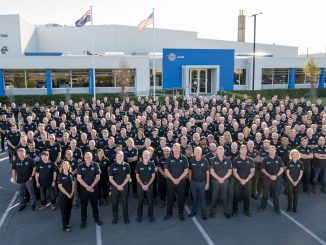
Boeing and the U.S. Space Force successfully completed the first major engineering design review for the Wideband Global SATCOM (WGS)-11+ communications satellite. This successful review demonstrates that Boeing is ready to proceed to the final system design phase. Production will begin next year at Boeing’s El Segundo factory, with delivery scheduled for 2024.
WGS-11+ features a modern digital payload that performs at twice the operational capability of its predecessors, increasing the availability of military-grade communications. Leveraging advances in Boeing commercial technologies, it will provide secure communications to connect U.S. and allied forces globally.
The current WGS constellation, consisting of 10 satellites, is the backbone of the U.S. military’s global communications system, providing flexible, high data-rate connectivity. Users include all U.S. military services, the White House Communications Agency, the U.S. State Department and international partners.
“Completing this engineering design review is a key milestone and brings us one step closer to delivering this groundbreaking satellite to the warfighter in record time, significantly improving capacity and coverage to our soldiers, sailors, airmen, Marines and allies,” said Col. John Dukes, chief of the Geosynchronous/Polar Division at Space and Missile Systems Center Production Corps.
“WGS-11+ uses narrower spot beams to deliver a stronger, more reliable connection exactly where it’s needed, which means better performance and greater flexibility than ever before,” said Troy Dawson, vice president of Boeing Government Satellite Systems.
In addition to U.S. military forces, the WGS constellation provides service to international partners including Australia, Canada, Denmark, Luxembourg, New Zealand, the Netherlands, the Czech Republic and Norway.
The U.S. Air Force Space and Missile Systems Center is harnessing advanced satellite communication technology from the private sector through the Wideband Global SATCOM (WGS) 11+ platform and its Pathfinder effort. The WGS-11+ effort is centered on capabilities that will provide more coverage beams, beam-formed bandwidth and frequency re-use than existing legacy systems, according to a release from the center known as SMC, located at Los Angeles Air Force Base.
The center’s Production Corps and Portfolio Architect’s Mission System Integration team, working with The Boeing Company, completed a crucial review agreement together with the Army and Navy. The effort defines the technical baseline for system performance across an aggressive five-year schedule.
Part of the WGS 11+ team is embedded at a Boeing facility, and is seeing firsthand the testing performance of the company’s commercial space application that employs similar digital payload technologies that the military can utilize.
“WGS 11+ is a Space and Missile Systems Center pacesetter for the rapid application and fielding of commercial technology,” according to an SMC statement. “The SMC Production Corps and Portfolio Architect’s Mission System Integration team jointly championed a successful first-ever, cross-corps systems requirements review (SRR) to help the government and Boeing reach a mutual agreement on a system performance specification to satisfy warfighter needs quickly.”
The WGS-11+ team been prototyping Pathfinder hardware units, which they will use to assess and reduce deployment risks in their final production build as part of their so-called Road to Preliminary Design Review effort. Ultimately, the WGS-11+ platform “will be capable of forming unique coverage areas anywhere within the field of regard—each sized optimally as mission needs demand.” It will also enable seamless broadband interconnectivity for X-band and Ka-band users, and advanced operations in a contested environment.
The effort is designed to provide military SATCOM with greater inherent resilience.
“The resilient design will deliver Combatant Commanders twice the mission capability through contested environments—improving capacity and coverage to soldiers, sailors, airmen and marines.” said Col. John Dukes, USAF, chief of the Geosynchronous/Polar Division, SMC Production Corps.



